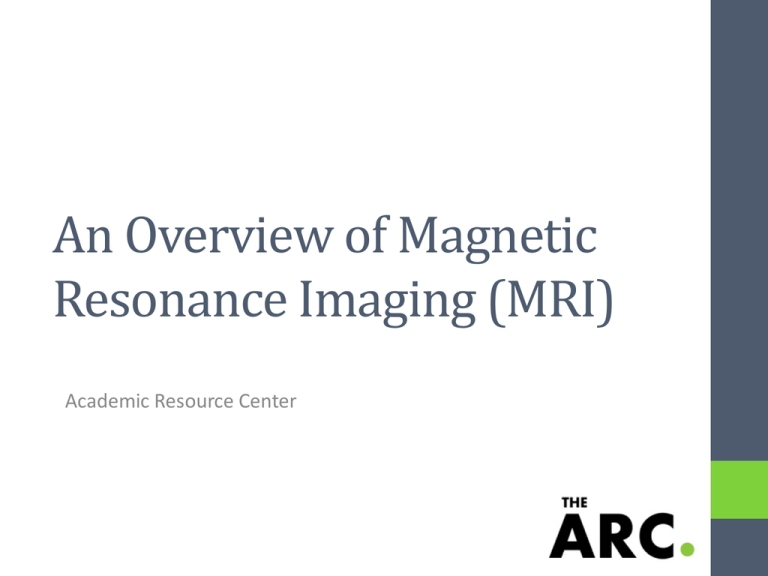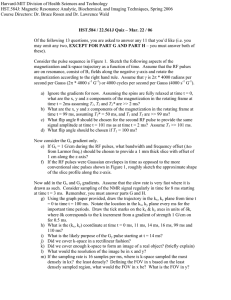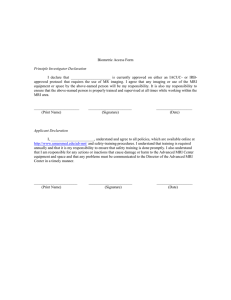An Overview of Magnetic Resonance Imaging (MRI)
advertisement

An Overview of Magnetic Resonance Imaging (MRI) Academic Resource Center Table of Contents • What is MRI? • General • MRI Machine • Who is it for? • How does it work? • • • • Magnetization vector Magnetization gradients Pulse sequences K-Space • Uses for MRI • References What is MRI? • A medical imaging technique that records changing magnetic fields • Also called Nuclear Magnetic Resonance (NMR) • Can give different kinds of images based on the pulse sequence (will talk about later) • Capable of complete body scans, but commonly used for brain An image of the brain obtained using MRI http://brainfunctionss.com MRI Machine • The main parts of the machine are: • RF Coils • Gradient Coils • Magnet *How these work together will be explained later • Patient is required to lay as still as possible • One scan can cost from $400 to $3,500 • A machine can cost as much as $1 million MRI Machine with main parts noted http://www.magnet.fsu.edu Who is it for? • MRI is safe for most patients • Patients who cannot receive a scan are: Medtronic’s Revo MRI SureScan pacemaker. First FDA approved MRIcompatible pacemaker in Feb. 2011 http://www.comhs.org • People who get nervous in small places (claustrophobic) • People with non-MRI-compatible implants • People with metal pieces near vital organs How does it work? • MRI stimulates a signal from the object using magnetic fields and radiofrequency pulses • MRI reads data using magnetic gradients and places it into k-space (frequency domain) • K-space (frequency domain) is translated into spatial domain giving an image! • To grasp the idea of the MRI process, it is important to review the following concepts: • • • • Understanding the Signal: Magnetization Vector Pinpointing the Signal: Magnetization Gradients Creating the Signal: Pulse Sequence Collecting the Signal: K-Space Before continuing… • The explanation in this presentation briefly goes over some of the key ideas of how MRI data is obtained • There are a lot of mathematical equations and physics involved in fully understanding the process • If you are interested in the details, refer to the references at the end of this presentation and/or take the following classes to satisfy your curiosity: BME309, BME438, ECE507 Magnetization Vector • MRI signals rely on the magnetization vector M • Vector M has a Mz and Mxy component • Signal is obtained from the Mxy component of the vector M • Signal intensity is dependent on Mxy magnitude http://chem4823.usask.ca Magnetization Vector • A strong constant magnetic field B0 is always present • In the direction of Mz+ • If M is not in the direction of Mz+, B0 forces M to return to Mz+ • Vector M is affected by Radio Frequency (RF) pulses of different angles • 90° angle tips vector M onto the Mxy plane Components of a Magnetization Vector. A tipped vector has both Mz and Mxy component http://www.spl.harvard.edu Magnetization Gradients Problem: How do we know where the signal is coming from? Answer: Magnetization Gradients • Magnetization Gradients allow each point in space to be distinguishable • Like placing an xyz coordinate system on the imaged object • Without magnetization gradients, there is no way to determine where the data came from in space • Called spatial encoding Magnetization Gradients • Three types of gradients • Slice selection – along the z-axis • Phase encoding – along x-axis • Frequency-encoding – along y-axis • Amplitude and duration of these gradients determine how information is read in k-space • Points in k-space are read by manipulating these gradients Pulse Sequence • Pulse sequence shows the timing of RF pulses and gradients • Determines the type of image • T1, T2, DWI • Some qualities of pulse sequences have special names • Inversion Recovery – 180 pulse before tip pulse • Spin Echo – 180 pulse after tip pulse (Prince) Pulse Sequence Like mentioned earlier, pulse sequence determines the type of image: T1 - Weighted T2 - Weighted Diffusion Weighted MRI is capable of obtaining all sorts of information! K-Space • K-Space is a space where MRI data is stored FT • The topics reviewed till now are the techniques to fill points in k-space K-space • By performing a fourier transform, k-space can be translated into an image Image http://www.revisemri.com/tools/kspace/ K-Space • K-space is sampled using magnetic gradients • Many methods to sample k-space: • • • • A)Parallel Lines B)Echo-Planar Imaging C)Spiral D)Radial http://www.springerimages.com • Each method has its own advantages and disadvantages K-Space • Data in k-space determines the final image • Below is an example of how k-space affects the final image: practicalfmri.blogspot.com Uses for MRI There are two uses for MRI: • Diagnostic • Find unhealthy tissue in the body • Locate tumors • Bone damage • Assess condition of tissue • Surgery planning • Research • Neuroscience • Determine relationships between images and disorders • Cancer • Understand how the brain works doing tasks References/Further Resources • http://www.imaios.com/en** • http://www.revisemri.com/* • http://www.mr-tip.com/serv1.php?type=db • www.biac.duke.edu/education/courses/fall05/fmri/handouts/2005_ Week2_BasicPhysics.ppt • Prince, Jerry. Medical Imaging and systems. Upper Saddle River, N.J.: Pearson Prentice Hall, 2006. *-Highly Recommended **-Highly highly recommended, but requires free sign up Presentation By: Arnold Evia





